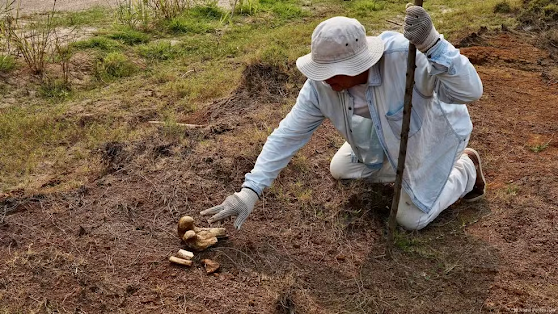The Purussaurus brasiliensis, the largest alligator that ever existed, has been extinct for 8 million years. Its bite was 20 times more powerful than that of a great white shark and twice much strong as that of a Tyrannosaurus Rex.
According to Aline Ghilardi, paleontologist at the Federal University of Rio de Janeiro, in an interview with the BBC in 2015, the animal needed to eat an average of 40 kg of food per day to sustain its body, which could exceed 12 meters in length.
From the Purussaurus to the giant sloth, fragments rescued by local communities, called riverside dwellers, help scientists from the Federal University of Acre to put together a puzzle about the past of Amazonian life.
FOSSILS,
LEGENDARY MONSTERS
AND CURUPYRA, THE ENCHANTED ONE
AMAZONAS STATE. BRAZIL. Pieces a Purussaurus vertebrae, the largest alligator that ever walked the planet, were found under a lemon tree: at the feet of Gerimar do Nascimento, on the banks of the Purus River, in the south of the state of Amazonas.
The relic was on display on a cliff when it was spotted by Gerimar, while sailing in his boat during a routine route, which he always takes when he goes to Boca do Acre, the nearest city.
"I saw that piece of bone and knew it wasn't from our time" says Geri, as he is known in the region. Photo: Nádia Pontes/DW
THREE VERTEBRAE! 🤡
Carlos D'Apólito, a professor at the Center for Biological and Natural Sciences at the Federal University of Acre (UFAC), who made a point of going to the community to retrieve the fossil, commented:
"There are three articulated vertebrae. It is not common to find them like this, one next to the other", says D'Apólito. "This can help science better understand the anatomy of the species, to understand in which part of the spinal column it would be".
The piece will be transported to the Paleontological Research Laboratory at UFAC, in Rio Branco (capital of the state of Acre), where it will be studied in detail and can help advance knowledge.
The name "Gerimar do Nascimento" will appear along with that part of the Purussaurus. This is one of the rare cases in which the identity of the person who found a fossil is known and documented, says Carlos D'Apólito, the researcher.
"There is a portion of the fieldwork that ends up being done by people who are not formally paleontologists, who remain invisible, and who sometimes do not even appear in the acknowledgements", says D'Apólito.
FOSSILS ON THE BANKS OF DRY RIVERS
Near the site, a group of seven researchers is concentrating their search for traces of extinct life. They are part of the expedition led by D'Apólito and are surprised every time they turn the earth.
The dry season in the Amazon is the time when paleontologists leave their laboratories and go out to collect, with a good chance of finding fossils on the exposed banks.
The level of Purus river during this season is well below average, say the boatmen who transported the team during the three days of fieldwork.
LEGENDS
The searches are taking place near a strip of land claimed by the Apurinã indigenous ethnic group.
Accustomed to seeing fossils there when the river is low, the natives believe that they are ancient bones dumped by a giant snake that devours animals and hides in the Purus. In Brazilian folklore, at many regions, this snake is called "Boitatá"
PAST'S VISIONS
The planet was warmer and this Amazon region was a large wetland, with immense lakes that sheltered Purussaurus and other giants.
Veteran Alceu Ranzi, retired after working for more than thirty years at UFAC (Center for Biological and Natural Sciences at the Federal University of Acre), accompanies the group that brings together several generations of paleontologists dedicated to deciphering extinct species buried beneath the Amazon Rainforest.
With fossil fragments in hand, Ranzi imagines the scenario in which these animals lived together – or competed. "We are walking along the bottom of a large lake. There was a very rich fauna here: alligators, turtles, sloths, rodents, all giants", says Ranzi.
During the Miocene, dinosaurs had become extinct about 40 million years ago. Humans did not yet exist.
Crocodiles, which shared the land with dinosaurs and are related to Purussaurus, adapted and survived, as did large mammals. The lush Amazon Rainforest probably did not yet exist.
SOURCES
PONTES, Nadia. Rios secos e ribeirinhos revelam fósseis de gigantes que viveram na Amazônia
G1/DW, SEPT102024
https://g1.globo.com/ciencia/noticia/2024/09/10/rios-secos-e-ribeirinhos-revelam-fosseis-de-gigantes-que-viveram-na-amazonia.ghtml
BENTES, Gabriel. Fóssil do maior jacaré que existiu no mundo é encontrado na Amazônia
O LIBERAL, SEPT062024
https://www.oliberal.com/brasil/fossil-do-maior-jacare-que-existiu-no-mundo-foi-encontrado-na-amazonia-1.859016




No comments:
Post a Comment
Note: Only a member of this blog may post a comment.